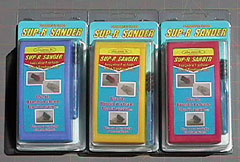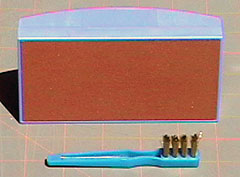|
 Sup-R
Sanders are plastic blocks having a tungsten carbide sanding surface. The
blocks are color-coded (fine, medium and coarse) for easy identification.
Other than the grit, the blocks are identical in size and shape. Sup-R
Sanders are plastic blocks having a tungsten carbide sanding surface. The
blocks are color-coded (fine, medium and coarse) for easy identification.
Other than the grit, the blocks are identical in size and shape.
Each block is approximately 2-3/4" wide x 5-1/4" long. The tungsten
carbide sanding surface is permanently adhered to the block and is smaller than
the outside dimension all the way around by approximately 1/16"
The blocks are comprised of top and bottom pieces that separate to store the
included brass wire brush used to clean particles from the block.
Because the sanding surface is made from tungsten it should last a very long
time. The tool carries a lifetime warranty, but I do not know if that
warranty applies to the surface wearing out or just to defects. The
manufacturer's recommended list price is $13.60 each.
I used these blocks as much as possible while working on my
DoodleBug 330
project — a profile fuselage, control-line
stunter. In addition to various grades of balsa, I used the blocks to
sand maple motor mounts, birch plywood, soft aluminum and dural aluminum.
I like the size of the block, but would prefer them to be a little
heavier. It would not be difficult to add weight to the blocks by
pouring leftover epoxy in the bottom.
Sup-R Sanders excel in two places that make them worth their weight in gold
— sanding plywood and aluminum. Normal
sandpaper wears out very quickly when edge-sanding plywood. Because I glue
paper to blocks, I always dread it when I have to sand plywood task because
doing so means the paper will need to be changed
— sometimes more than once before the job is finished.
I used these blocks for that same task and they were not phased a bit.
That means my sandpaper blocks will last a lot longer now.
 All three blocks remove stock quickly when sanding balsa. The coarse
block tears away balsa at an incredibly fast rate which will make it excellent
for roughing in wing tips blocks and similar tasks. I would say that the
coarse block falls somewhere between a wood rasp and 120 grit paper.
Roughly it is probably about equivalent to 60 or 80 grit paper. All three blocks remove stock quickly when sanding balsa. The coarse
block tears away balsa at an incredibly fast rate which will make it excellent
for roughing in wing tips blocks and similar tasks. I would say that the
coarse block falls somewhere between a wood rasp and 120 grit paper.
Roughly it is probably about equivalent to 60 or 80 grit paper.
I chose to cut the landing gear from dural aluminum plate. The edges of
the gear were fairly ragged after cutting them with my scroll saw. I have
never had good success using metal files on aluminum. They clog up quickly
with galled aluminum and I generally find files awkward to work with.
These blocks did not clog or dull and made short work of the task. The
Sup-R Sanders felt much more comfortable than metal files and were easier for me
to control.
 The
blocks have only two short-comings. The first is that the blocks seem too
flexible. They are stiff enough to remain flat on softer woods because less
pressure is applied while sanding. The
blocks have only two short-comings. The first is that the blocks seem too
flexible. They are stiff enough to remain flat on softer woods because less
pressure is applied while sanding.
I have not actually tried to sand a hardwood plank flat with any of these
blocks, so it may not actually be a problem. However, it is something that
I would pay attention to until I was more confident in the block.
A thicker bottom would ensure the block could not flex. I would like it to
be at least 1/4” and preferably 1/2” thick.
The second item is that the blocks can not sand all the way into a corner
because the tungsten pads are slightly smaller than the bottom of the block.
Kentool does not indicate the grit equivalency of the blocks which would be
nice, but is not really necessary. The fine grit would actually be
considered medium to coarse on soft balsa wood. Therefore, Sup-R sanders
can replace coarse and some medium blocks, but fine sandpaper blocks will still
be necessary.
Overall I like these tools and recommend them. They are a welcome
addition to my sanding tools and will save me a great deal of time and money
from replacing sandpaper.
|
![]()